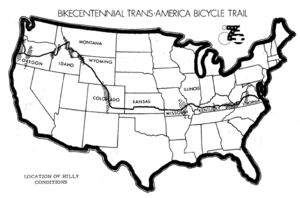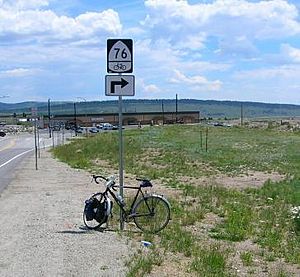Bikecentennial facts for kids
Bikecentennial '76 was a huge bicycle adventure across the United States. It happened in the summer of 1976. This special event celebrated America's 200th birthday, known as the United States Bicentennial.
Cyclists rode on a special path called the TransAmerica Bicycle Trail. This trail went through ten states, many national forests, and two national parks. It stretched from Astoria, Oregon, all the way to Yorktown, Virginia. That's about 4,250 miles (6,840 km)! The route was picked to go through small towns and quiet country roads.
Around 4,100 people joined the event. They came from all 50 U.S. states and many other countries. Riders could choose different trips. Some rode the whole 82-day, cross-country journey. Others picked shorter trips, like a 12-day ride through the Rocky Mountains. About 1,750 cyclists rode the entire trail. Most riders were in groups of 10 to 12 with a leader. About a quarter rode by themselves. The cyclists carried their own camping gear, food, and other items in special bags called panniers on their bikes.
Bikecentennial started as a non-profit group in 1974. After the 1976 event, it kept helping bike travelers. It created more routes and maps. In 1993, Bikecentennial changed its name. It is now called the Adventure Cycling Association.
Contents
How Bikecentennial Started
The Idea for a Big Bike Ride
The idea for a bike tour across the U.S. in 1976 came from Greg Siple. He thought of it in 1973. At the time, Greg, his wife June, and friends Dan and Lys Burden were on a huge bike trip. They called it Hemistour. They rode 18,000 miles from Anchorage, Alaska, to Tierra del Fuego Province, Argentina. Their goal was to promote biking and staying in hostels.
A few months later, as Hemistour was in Mexico, June Siple came up with the name "Bikecentennial." Greg Siple had already started a yearly bike tour in Ohio. It was called the Tour of the Scioto River Valley (TOSRV). He began it with his father in 1962.
Building the Event
During their Hemistour trip, Dan Burden got very sick. He and his wife, Lys, had to leave the tour. They then focused on making the Bikecentennial event happen. Meanwhile, the Siples continued their long bike journey through the Western Hemisphere.
The TransAmerica Bicycle Trail
Planning the Route
The special Bikecentennial route was named the TransAmerica Bicycle Trail. Lys Burden and many Bikecentennial helpers created it. They had several important rules for choosing the path. The roads needed to be good for bikes and have little traffic. The route also needed interesting places to see. It also had to have places for camping and buying food.
It's important not to mix up the Bikecentennial TransAmerica Trail with another route. There's a different one called the Trans America Trail (TAT). That one is mostly for motorcycles and goes off-road. It's also popular with mountain bike riders.
States and Landmarks on the Trail
The TransAmerica Bicycle Trail crossed many states and interesting places. Here are some of them:
- Virginia: Yorktown, Williamsburg, Richmond area, Charlottesville, Lexington, Roanoke area, Appalachian Trail, Breaks Interstate Park. Riders crossed parts of the Blue Ridge Parkway and Appalachian ridges.
- Kentucky: Elkhorn City, Hazard, Berea, Bardstown, Lincoln's birthplace, Rough River Dam State Park, Ohio River. Riders crossed Appalachian and Cumberland Plateau ridges.
- Illinois: Cave in Rock State Park, Carbondale, Chester (home of the Popeye statue), Mississippi River.
- Missouri: Farmington, Johnson's Shut-Ins State Park, Ozark National Scenic Riverways, Eminence, Marshfield. Riders crossed Ozark Plateau ridges.
- Kansas: Pittsburg, Eureka, Newton, Hutchinson area, Quivira National Wildlife Refuge, Larned, Ness City, Tribune.
- Colorado: Eads, Pueblo (the halfway point!), Cañon City, Royal Gorge, South Park, Breckenridge, Kremmling, Walden. Riders went over Hoosier Pass (the highest point at 11,541 feet or 3,518 meters) and Willow Creek Pass.
- Wyoming: Saratoga, Rawlins, Great Divide Basin, Lander, Wind River Reservation, Grave of Sacagawea, Grand Teton National Park, Yellowstone National Park. Riders crossed Muddy Gap, Togwotee Pass, and Craig Pass.
- Montana: West Yellowstone, Quake Lake, Virginia City, Dillon, Big Hole National Battlefield, Hamilton, Missoula (where Bikecentennial's main office was). Riders went over Badger Pass, Big Hole Pass, Chief Joseph Pass, Lost Trail Pass, and Lolo Pass.
- Idaho: Lochsa River, Nez Perce Reservation and National Historical Park, Grangeville, Council, Brownlee Dam, Hells Canyon. Riders crossed White Bird Hill Summit.
- Oregon: Baker City, John Day, Prineville, Eugene (the largest city on the route), Reedsport, or Corvallis, Dallas, Otis, Astoria. Riders went over Flagstaff Hill, Tipton Summit, Dixie Pass, Ochoco Summit, and McKenzie Pass.
The route crossed the Continental Divide nine times. This happened in Colorado, Wyoming, and Montana. The Continental Divide is like a big line across the mountains. It separates which way rivers flow.
The Bikecentennial Ride
The TransAmerica Bicycle Trail officially opened on May 14, 1976. Groups riding the whole coast-to-coast trip started from either Astoria, Oregon, or Yorktown, Virginia. Other groups, doing shorter tours, began their rides from places in the middle of the country.
The prearranged groups had about 10 to 12 riders. Each group had a leader. These leaders were trained by the Bikecentennial staff. They helped manage the group's money. They also helped organize chores like buying food, cooking, and cleaning up campsites.
Who Supported Bikecentennial?
Many groups helped make Bikecentennial a success. The Wally Byam Foundation gave support. Bike companies like Huffy and Shimano also helped. Other supporters included the Bicycle Institute of America. The American Revolution Bicentennial Administration also provided assistance.
Bikecentennial's Lasting Impact
The Bikecentennial event in 1976 was a huge success. Because of this, the Adventure Cycling Association kept growing. They mapped out many more bike routes across the United States and Canada.
Today, the Adventure Cycling Route Network is very large. It has over 44,000 miles of bike routes. It is the biggest network of bicycle routes in North America.
Since 2014, there has been an annual bike race called the Trans Am Bike Race. This race uses almost the exact same route as the original Bikecentennial trail.



